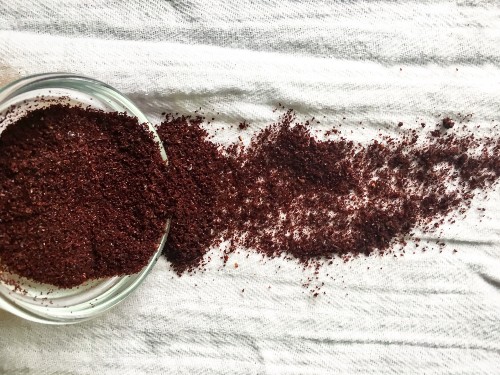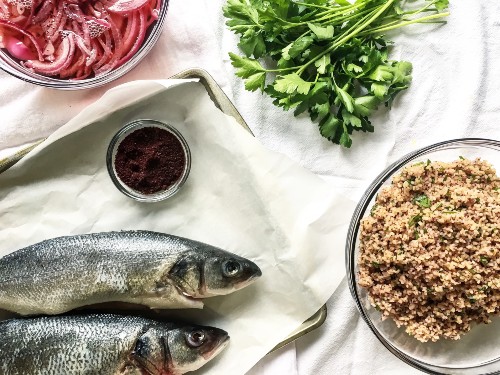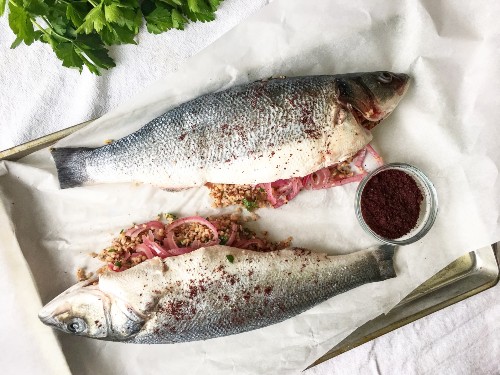On this page you’ll discover all you ever wanted to know about sumac, where to find it, and how to use it in a variety of culinary masterpieces.
What Is Sumac?

What is Sumac?
Sumac is a bright red, fuzzy fruit that grows in clusters on a small bush. These “fuzz balls” are usually dried before consuming, and they taste bright and citrusy with a slight sour tang. When you get it in the market, it usually looks deep red and is coarsely ground. It basically has all the benefits of a citrus fruit like lemon or lime without any of the mess and juice that is required to extract that citrus flavor from a whole fruit. This makes it ideal to use in spice rubs or any recipe where you aren’t interested in increasing the liquid content.
You probably didn’t know that sumac is poisonous- unless of course, you have had experience with the itchy, uncomfortable rash that poison sumac can cause. Don’t worry; poison sumac is the white fruit, not the red, edible one. Red sumac is actually far from poison; it’s really good for you! It’s loaded with antioxidants, vitamin A, and vitamin C, and most importantly, it’s delicious.
Sumac’s claim to fame (until now) has been as one of the key ingredients in za’atar. It should come as no surprise then, that sumac is highlighted in many recipes for Middle Eastern cooking. But wait, it’s not just limited to that! Chefs all over the world have been using sumac in anything from appetizers to desserts, usually very creatively.. Personally, I credit chef, cookbook author, and restaurateur Yotam Ottolenghi for bringing sumac into the spotlight. Many of his recipes feature sumac in the most beautiful way possible, per his usual style.
How To Use Sumac in Cooking

My personal favorite way to utilize sumac is in a recipe of sumac pickled onions. It’s the kind of thing you can throw on a salad, taco, sandwich, hot dog (just a spoon??), etc. to make everything taste about 10 times better. I’ve thrown some of these citrusy onions into my recipe below, so feel free to take the extra sumac onions and store tightly sealed in your fridge for up to two weeks of maximal deliciousness on e’rythang!
There is no strict technique to using sumac. It’s not like you have to put it in your dish only at the start of cooking or only at the end. You are more than welcome to use it on both occasions or all occasions- just add a dash and see how it goes! But before you start, take a little taste of the raw spice so you know what you’re adding to your food. Always gauge your flavors and measure them out into your hand or a small bowl before adding copious amounts (or any amounts) of a spice to your dish. We’ve all had those terrible occasions where we messed up that crazy expensive piece of meat because the cap fell off the… insert spice here.
Where Can I Buy Sumac?
According to the CRC, pure sumac does not need a hechsher. But since you and I most likely do not frequent Middle Eastern spice markets (unless you live in Israel), your best option for getting sumac is to get Pereg brand. It’s sold in many kosher supermarkets.
Tabouli Stuffed Branzino with Sumac Pickled Onion

Whole fish is super impressive because there is always that unsaid expectation that maybe you caught and prepared your meal, which is undeniably awesome. No one has to know otherwise. My go-to whole fish recipe always uses a ton of citrus. I love the way it brightens the flavor, but I don’t love running the risk of denaturing the proteins with all that acid! Here’s a thought… What would happen if we used sumac instead? I suspect good things will happen.
Serves two very hungry people or four not super hungry people
For the Fish
2 whole branzini
For the Pickled Onions
1 red onion, sliced thin
1/2 cup apple cider vinegar
1/3 cup sugar
1 cup boiling water
1 tablespoon salt
1/4 teaspoon freshly ground black pepper
1 tablespoon sumac
For the Tabouli
1 cup fine bulgur
1 and 1/3 cups boiling water
1/4 cup chopped parsley
1 tablespoon olive oil
2 teaspoons honey
2 tablespoons sumac
1 teaspoon salt
1/2 teaspoon fresh ground black pepper
Directions
1. Set the oven to 400 degrees Fahrenheit.
2. In a medium bowl, add the vinegar, sugar, water, salt, pepper and sumac to make the pickling liquid. Add in the sliced onions, set aside, and allow to rest for 10 minutes.
3. In another bowl, add the bulgur and boiling water. Cover and allow to sit for 10 minutes.
4. In the meantime, open the fish and clean out the insides if your fishmonger has not done so already. Pat the fish dry.
5. Prepare a baking sheet lined with parchment paper.
6. Uncover the bulgur and fluff with a fork. Add the parsley, olive oil, sumac, salt and pepper to the bowl and mix to create tabouli.
7. Stuff the cavity of the fish with the bulgur mixture. Remove onions from the pickling liquid. Top the bulgur tabouli with one to two tablespoons of onions. Store the remaining onions for later use.
8. Brush the top of the fish with olive oil and sprinkle liberally with salt and pepper along with a pinch of sumac.
9. Bake for 25–30 minutes or until an internal thermometer registers at least 135˚ Fahrenheit.
10. Allow the fish to cool for 5–10 minutes before transferring to a platter and serving. Serve alongside remaining pickled onions and bulgur.

Other creative ways to use sumac:
– On popcorn with a little salt and butter
– Atop your stunning loaves of challah
– As a balance to the sugar in your favorite meat recipe
– Boiled in tea with a bit of honey and then frozen (pink lemonade popsicles anyone?)
– In/on yogurt
– On crispy chickpeas
– Sprinkled over tomatoes
– As a spice rub for lamb or London broil (no marinade time necessary!)
– On top of hummus (not so creative but must be said)
– Mix 1 cup sugar + 1 cup coconut oil + 2 tablespoons sumac for an anti-aging sugar scrub
– Boiled into a sugar syrup for a sumac cocktail
– In frosting (yesss!)
– Ground with sugar to make a sweet and sour candy sugar
– Mixed with hot sauce and honey for wings (getting super excited about this one!)
More Recipes with Sumac
1. Artichoke and Poached Egg by Joodie the Foodie
I love love love artichoke, but my usual dipping sauce is something with mayonnaise or cream and I’m trying to stay away from that as much as possible. I was thinking of alternatives, and flipping through my feed I kept seeing deliciously runny egg yolks – lightbulb – dip the artichoke leaves in yolk! I set out to try my experiment and was amazed at how delicious it turned out!
![]()
![]()

2. Za’atar Roasted Chicken over Sumac Potatoes by Adeena Sussman
On countless visits here before I made Israel my home, I’d buy giant bags of za’atar from the shuk; that way, after I left and no matter where I was, if I was pining for the sun and spice of this magical place, I could sprinkle it back into my life, if even just for the duration of a meal. For something that takes 10 minutes to throw together, the roasted chicken is a masterpiece. I rest the bird right on top of the potatoes, so the za’atar-scented drippings coat the tangy, sumac-coated potatoes while they cook in unison. If you’re having a crowd, throw this in the oven during cocktail hour, then pull it out for oohs and aahs. If you’re feeding a smaller group, be happy because this chicken, pulled off the bone and tossed into a salad, makes a killer next-day lunch.

3. Roasted Duck and Potatoes by Chef Yitzy Goldstein
Chef Yitzy shares his one-of-a-kind duck and potato recipe! Make it for Shabbos, then use the leftover shreds of duck meat for your Sunday barbecue salad!
4. Mediterranean Cabbage Salad by Marla Rottenstreich
As a busy working mom, fitness instructor and wellness coach, I understand the need to prepare mishloach manot that are healthy, can be made days in advance, and within a tight budget (and timeframe!). This hardy cabbage salad with peppers and radishes checks all the boxes.
5. Roasted Potatoes with Chestnuts and Mushrooms by Ruth Fox and Vicky Cohen

6. Pizza Bassar by Chanie Apfelbaum
Inspired by the popular Middle Eastern dish of hummus bassar, hummus topped with a spiced ground beef mixture, pizza bassar is baked on premade laffa that crisps up into the perfect pizza crust!
7. Fish Kebabs with Chraime by Bonnie Stern and Anna Rupert
Chraime is a spicy North African tomato sauce usually cooked with fish. In Israel, this dish is often served for Friday night dinner, and as an appetizer during the Jewish holidays.

8. Delicious Chicken Wrap by Tehila Kohanim
You can use either of the marinades below. If desired, you can divide your chicken and use different-flavored marinades for each portion.
Sumac is an incredible spice with a lot of versatility and personality. How are you going to use it? Let us know in the comments!









